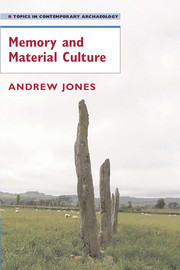Book contents
- Frontmatter
- Contents
- Preface
- 1 Memory and Material Culture?
- 2 From Memory to Commemoration
- 3 People, Time, and Remembrance
- 4 Improvising Culture
- 5 Continuous Houses, Perpetual Places: Commemoration and the Lives of Neolithic Houses
- 6 Culture, Citation, and Categorisation: Regionality in Late Neolithic Britain and Ireland
- 7 Chains of Memory: The Aesthetics of Memory in Bronze Age Britain
- 8 The Art of Memory: Memory, Inscription, and Place
- 9 Tracing the Past: Landscape, Lines, and Places
- 10 Coda
- References
- Index
5 - Continuous Houses, Perpetual Places: Commemoration and the Lives of Neolithic Houses
Published online by Cambridge University Press: 07 December 2009
- Frontmatter
- Contents
- Preface
- 1 Memory and Material Culture?
- 2 From Memory to Commemoration
- 3 People, Time, and Remembrance
- 4 Improvising Culture
- 5 Continuous Houses, Perpetual Places: Commemoration and the Lives of Neolithic Houses
- 6 Culture, Citation, and Categorisation: Regionality in Late Neolithic Britain and Ireland
- 7 Chains of Memory: The Aesthetics of Memory in Bronze Age Britain
- 8 The Art of Memory: Memory, Inscription, and Place
- 9 Tracing the Past: Landscape, Lines, and Places
- 10 Coda
- References
- Index
Summary
In the last series of chapters we have seen that the material properties of objects are crucial to their use in commemorative practices, that these properties are drawn on in commemorative performances, and that the temporal relationship between material culture and the person is significant to how objects are utilised. I want to reprise each of these points by discussing the example of houses in two regions of Neolithic Europe.
As archaeologists we are faced with a challenge when attempting to consider the long-term durability of social practices against the short-term nature of social change. Ian Hodder (1998a) deals with the relationship between structure and contingency by proposing the long-term durability of a symbolic scheme centred on the house which is played out over the course of the European Neolithic. In earlier works he proposes that the concept of the home – the domus – provides a metaphor for the domestication of society (Hodder 1990, 41). I have always felt uncomfortable with this interpretation because I found it difficult to see how the concept worked in practice. Clearly Hodder also had the same reservations because in a later revision of his ideas he offers a more concrete proposal (Hodder 1998a). Rather than treating the house as a metaphor for domestication, he notes that the very durability of the house is the means of its reproduction as a concept.
- Type
- Chapter
- Information
- Memory and Material Culture , pp. 91 - 121Publisher: Cambridge University PressPrint publication year: 2007



